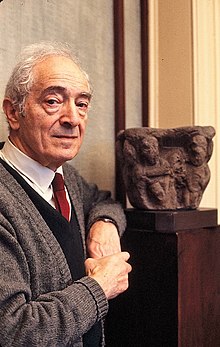Meyer Schapiro | |
|---|---|
 Meyer Schapiro in 1981 | |
| Born | September 23, 1904 Šiauliai, Russian Empire (present-day Lithuania) |
| Died | March 3, 1996 (aged 91) New York City, U.S. |
| Nationality | American |
| Other names | M. Morrison (pen name)[1] |
| Education | Columbia University |
| Occupation(s) | Philosopher, professor, writer |
| Years active | 1928–1973 |
| Movement | Trotskyism |
| Spouse | Lillian Milgram Schapiro |
| Children | 2 |
| Relatives | Morris Schapiro (brother), Jacob Collins (grand-nephew) |
| Awards | Alexander Hamilton Medal, National Institute of Arts and Letters (member) |
Meyer Schapiro (23 September 1904 – 3 March 1996) was a Lithuanian-born American art historian who developed new art historical methodologies that incorporated an interdisciplinary approach to the study of works. An expert on early Christian, Medieval and modern art, he explored periods and movements with an eye toward their works' social, political and material constructions.
Credited with fundamentally changing the course of the art historical discipline, Schapiro's scholarly approach was dynamic and it engaged other scholars, philosophers and artists. An active professor, lecturer, student, writer and humanist, he maintained a long professional association with Columbia University in New York.
- ^ Sidorsky, David (8 May 2008). "Sidney Hook". Stanford Encyclopedia of Philosophy. Retrieved 25 August 2018.